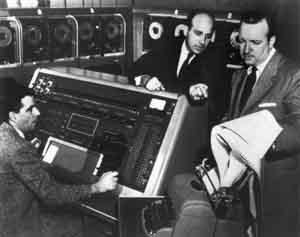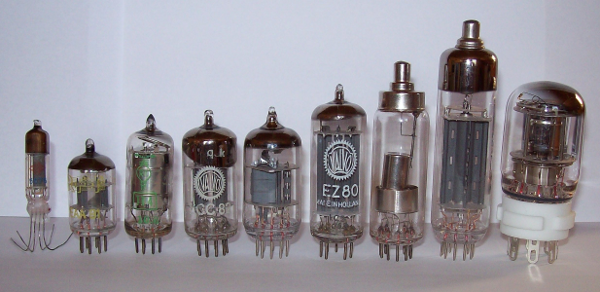This article is more than 1 year old
Why won't you DIE? IBM's S/360 and its legacy at 50
Big Blue's big $5bn bet adjusted, modified, reduced, back for more
The business that broke the bank
IBM had been moving into data-processing, too, and it had a variety of systems that used vacuum tubes and transistors. Business was brisk.
But IBM wasn't alone and others were moving into computers: Honeywell, Burroughs and Control Data Corp. Notable among rivals was Remington Rand: its machine, the UNIVAC 1, had successfully calculated the winner of the US presidential election on TV on the evening of 4 November, 1952.
The real killer was the fact that the UNIVAC 1 came from two of brains behind ENIAC itself: J Presper Eckert and John Mauchly, who'd gone into business as the Eckert-Mauchly Computer Corporation. They'd started the UNIVAC 1 as a project for the US Census Bureau on an initial deposit of $400,000 in 1951. But the project broke them, and they sold to Remington Rand, famous for typewriters and razors, who completed the UNIVAC 1 at a cost of $1m.

A UNIVAC with its co-creator J. Presper Eckert
(center) and US TV reporter and anchor Walter Cronkite (right)
UNIVAC 1 was smaller than ENIAC, just 5,200 vacuum tubes, and faster with an addition time of 120 milliseconds, multiplication time of 1,800 milliseconds, and division time of 3,600 milliseconds. It was relatively easy to program, too.
Revenue in 1962 was $2bn, up from $4m in 1914. But growing competition was making IBM look like just another computer company and people were starting to think company's best days were behind it and its growth had plateaued.
IBM wasn't helping itself either. The company was saddled with supporting and developing a diverse set of non-compatible products for both high- and low-end needs that were all very much single-purpose machines.
Making things worse, IBM engineers had been busy on custom mainframes. These included the Naval Ordnance Research Calculator (NORC) and SAGE (Semi-Automatic Ground Environment) AN/FSQ-7 family of networked systems used in US air defence.
And by the early 1960s, IBM was planning on adding yet another system to the already complex mix - the 8000, which it was calling "a massively powerful super computer".
Middle-aged SPREAD
Under a relatively new CEO - Thomas J Watson Jnr - IBM management convened a special committee in autumn 1961 to evaluate the company's operations. Named SPREAD, the committee's name stood for Systems Programming, Research Engineering and Development. There were no sacred cows: everything IBM was doing with computers and peripherals was to be examined to determine product and development direction for the next 10 years.
The 80-page report was delivered by Christmas. In short, it recommended a range of five scalable systems varying only in processing power, with the largest being 200 times more powerful than the first, and each device designed to be compatible with the others. The idea was for a program that ran on one could run on all systems and that all computers would use standard interfaces - nothing custom.
The processors must have new capabilities not present in existing IBM computers the new family would not be compatible with IBM's existing systems.
Watson wasn't sure about what he was about to undertake.
S/360 arrives
The System 360 "was the biggest, riskiest decision I ever made, and I agonized about it for weeks, but deep down I believed there was nothing IBM couldn't do," he wrote in his memoirs, Father, Son and Co: My Life at IBM and Beyond.
What emerged from SPREAD was a family of six compatible machines - the S/360 30, 40, 50, 60, 62 and 70, which Watson Jnr announced on 6 April, 1964.
The S/360 was remarkable for a number of conceptual and technological reasons. First, it separated design from build, so systems could be replicated. This allowed components to be specced and manufactured using a standard process, ensuring the S/360 wasn't a one-off or relatively custom build that was hard to turn into a successful business - like UNIVAC.
Part and parcel of this was the "compatible" moniker of the S/360. IBM built what today might be called a plug-and-play stack: that is, all components from circuits to memory, storage, printers and screens were designed and manufactured by IBM.
The parts' compatibility made the S/360 modular: Watson Jnr announced six systems but they came in 19 combinations of power, speed and memory size. The smallest was capable of 33,000 additions per second and the biggest 750,000. A total of 54 peripherals were also available from IBM: from magnetic storage devices and visual display units to printers, card punches and more.
The benefit for IBM was a system that was relatively low-cost to make and easy to customise to meet a relatively broad number of customer scenarios.
Also, the hardware was separate from the software program and the program could - in theory at least - run on difference versions of the S/360. The plug-and-play nature of the hardware side thus extended to the software.
This was, in truth, one of the hardest parts of the dream to deliver: IBM struggled to make the operating systems and the apps run on different sized S/360s and to make the underlying operating systems capable of being multi-function.

Flash-Gordon tech - vacuum tubes, once the state of the art
As a mainframe, the S/360 wasn't a new beast. What IBM did succeed in doing was bringing the manufacturing, technical specification and use of such systems into what we might call the modern age. The S/360 changed the face of what had been at best a cottage and at worst Heath-Robinson industry: it turned making mainframes in to a Henry-Ford-style, large-scale manufacturing process.
Machines finally evolved from the era of Flash-Gordon-esque vacuum tube processors – from looking like light bulbs that were state of the art in the 1930s and 1940 to looking more in sync with the integrated electronics era of the post-war world.
The S/360 introduced new IBM technology, it found a use for existing IBM technologies, and it embraced new thinking in the industry.
